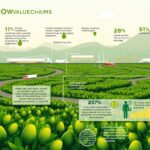The way we travel is about to change a lot. Robotaxis and air taxis are leading this change. The global robotaxi market is expected to hit $40 billion by 2030, growing fast.
This growth will have a big impact on 2025 economic trends and the future of transportation.
Autonomous vehicles will change city travel. They will cut down on traffic and pollution. Companies like Waymo and Uber are working hard on this technology.
The rise of robotaxis and air taxis will deeply affect the economy. It will bring new chances and challenges. As we get closer to 2025, it’s key for businesses and leaders to understand these shifts.
Key Takeaways
- The global robotaxi market is expected to grow significantly by 2030.
- Autonomous vehicles will transform urban transportation.
- Companies like Waymo and Uber are leading the way in autonomous technology.
- The economic implications of robotaxis and air taxis will be substantial.
- Understanding these changes will be key for businesses and policymakers.
The Current State of Autonomous Mobility in 2025
In 2025, the world of autonomous mobility is changing fast. Robotaxis and air taxis are making big waves, changing city travel forever.
Robotaxi Deployment Across Major U.S. Cities
Robotaxis are rolling out in big U.S. cities. Leaders like Waymo, Cruise, Baidu, and Tesla are at the forefront. They hold over 70% of the market, showing their big role in self-driving cars.
This move is not just making travel easier. It’s also changing how we get around cities.
Air Taxi Progress and Commercial Timeline
Air taxis are also making big strides. Companies are racing to launch them commercially. The air taxi market is set to boom, thanks to the need for quick, efficient city travel.
Investments in electric vertical takeoff and landing (eVTOL) technology are key for air taxis.
Key Market Players and Recent Developments
The autonomous mobility market is led by big names like Waymo, Cruise, Baidu, and Tesla. They’re pushing the tech forward and forming key partnerships. Recent news includes expanding into new areas and upgrading driving tech.
Tesla Cybercab and Waymo: Leading the Robotaxi Revolution
Tesla and Waymo are changing the game with their robotaxi services. They aim to make a big splash in the transportation world. Tesla plans to start its robotaxi service by 2026 and wants a million vehicles by 2030.
Tesla’s Autonomous Technology and Market Strategy
Tesla is focusing on the Cybercab for its robotaxi service. It uses Tesla’s Autopilot system and a network of sensors and software.
Cybercab Technical Specifications
The Tesla Cybercab will have top-notch tech. It will have advanced driver-assistance systems and AI navigation. Key features include:
- High-resolution cameras and sensor suites for better perception
- Advanced machine learning algorithms for predictive maintenance
- High-capacity computing for real-time data processing
Pricing Models and Accessibility
Tesla plans to make Cybercab affordable. It wants to challenge traditional taxi and rideshare services. The company will offer flexible pricing to make it easier for people to use.
Waymo’s Expansion and Competitive Position
Waymo, a part of Alphabet Inc., is a leader in autonomous vehicles. It’s growing fast in the robotaxi market. Waymo is investing a lot in tech and infrastructure, making it a big rival to Tesla.
Economic Impact on Traditional Taxi and Rideshare Services
The rise of robotaxis will change the taxi and rideshare industry. Autonomous vehicles might replace human drivers, leading to job losses. But, new jobs will come up in car maintenance and AI.
The Air Taxi Ecosystem: Joby Aviation, Archer, and Beyond
Urban air mobility is on the verge of a major leap forward. This is thanks to companies like Joby Aviation and Archer. The air taxi world is changing fast, with new tech and infrastructure.
Joby Aviation’s Certification Progress and Commercial Launch
Joby Aviation is moving quickly towards certification. They aim to start commercial flights soon. Their electric vertical takeoff and landing (eVTOL) plane is set to change city travel.
Archer Aviation’s Urban Air Mobility Solutions
Archer Aviation is also a big name in air taxis. They’re working on efficient and green flying solutions. Their focus is on cutting down emissions.
Infrastructure Development for Air Taxi Operations
Building the right infrastructure is key for air taxis to take off. This includes:
- Vertiport construction
- Charging and maintenance systems
- Integration with existing transportation networks
Vertiport Construction Progress
Building vertiports is a big part of air taxi setup. Joby Aviation and Archer are teaming up with city planners. They’re making vertiports that are safe, efficient, and easy to get to.
Charging and Maintenance Systems
Work on charging and maintenance systems is underway. These systems will meet the special needs of eVTOL planes. They’ll make sure flying is reliable and smooth.
The air taxi world is set for big growth, thanks to new ideas and money. As Joby Aviation and Archer keep improving, we’ll see a big change in how we move around cities.
2025 Mobility Trends Economic Impact: Analysis and Projections
In 2025, the economic impact of mobility trends will be huge. This is thanks to new tech in self-driving cars. The way we move around will change a lot, affecting the economy.
Job Creation in Autonomous Transportation Sector
The self-driving car industry will bring new jobs. These will include roles in AI, car upkeep, and managing mobility services. Experts say these new jobs will help balance out the loss of old ones.
Workforce Displacement and Transition Challenges
But, there will also be jobs lost, mainly for drivers. It’s important to have plans to help workers move to new roles.
Experts say, “Upskilling and reskilling workers is key. It helps them keep up with new tech.”
GDP Contribution of New Mobility Technologies
New mobility tech will boost GDP. It will make transportation more efficient and cost-effective. This will help the economy grow.
Regional Economic Development Patterns
Where we use self-driving cars will shape local economies. Places that invest in mobility will likely grow faster. But, not all areas will adopt at the same rate, leading to economic differences.
The effects of 2025 mobility trends will be complex. There will be both good and bad changes. Understanding these changes is vital for the industry’s future.
Regulatory Frameworks Enabling Autonomous Transportation Growth
The future of transportation is being shaped by new rules that help autonomous vehicles grow. As more autonomous vehicles hit the roads, governments worldwide are setting up clear rules. They are making sure robotaxis and air taxis meet safety standards.
Federal Aviation Administration’s Air Taxi Certification Process
The Federal Aviation Administration (FAA) is key in certifying air taxis. The FAA has set rules for air taxi makers to follow. This includes strict tests to check if air taxis are safe and work well.
Department of Transportation’s Autonomous Vehicle Guidelines
The Department of Transportation (DOT) has made guidelines for self-driving cars. These rules cover safety, cybersecurity, and how they work. They help make sure autonomous vehicles are safe and reliable.
State-Level Legislation and Local Permitting
States and local areas also play a big role in autonomous vehicles. States make laws for testing and using self-driving cars. Local areas give permits and watch how these vehicles operate.
By 2027, over 50 big cities will allow robotaxis with the right rules. This support will lead to more money going into mobility tech. It will shape the future of how we move around.
- Regulatory frameworks are key for autonomous transportation growth.
- Governments are setting up clear rules and certification for robotaxis and air taxis.
- Rules at the federal and state levels are being made to help deploy autonomous vehicles.
Investment Landscape in Mobility Technology
Autonomous vehicles and air taxis are becoming more popular. This is changing how we invest in mobility technology. By 2025, investments in CASE (Connected, Autonomous, Shared, and Electric) tech could hit over $1 billion a year.
Venture Capital Funding Trends
More money is going into autonomous transportation. Big names like Tesla and Waymo are leading the way. Investors see a lot of promise in this area.
Public Market Performance
Publicly traded mobility companies are doing well, but not all are. How the market reacts to new tech will shape future investments.

Government Support
Government help is key for new mobility tech. Subsidies and programs reduce risks for early investors. This encourages more growth in the field.
The world of mobility tech investment is lively. With lots of venture capital and government support, innovation is thriving. As this area grows, we’ll see new chances and hurdles.
Urban Infrastructure Transformation for New Mobility Models
The future of transportation is changing with smart infrastructure and advanced networks. Cities are updating their roads and systems for robotaxis and air taxis. This is a big change in how we move around.
Smart Road Systems and V2X Communication Networks
Cities are spending a lot on smart roads and V2X networks. These help new mobility models work together. They make roads safer and more efficient by sharing data in real-time.
For example, smart roads have sensors and systems that give traffic updates. They also help traffic lights work better.
Economic Impact of Infrastructure Investment
Investing in new mobility infrastructure has many benefits. It creates jobs in construction and tech. It also boosts the economy by making travel faster and reducing jams.
Such investments can also raise property values. They make cities better places to live.
By focusing on smart infrastructure and V2X, cities can make transportation better. This will help robotaxis and air taxis become more common.
Consumer Adoption Patterns and Market Economics
People’s willingness to try new ways of getting around is key to the big changes expected in 2025. With 65% of urban dwellers ready to use robotaxis by 2030, we’re on the verge of a big change in how we move around.
Demographic Analysis of Early Adopters
Robotaxis and air taxis are most appealing to city folks, tech lovers, and those who care about the planet. Surveys show that younger people are more into autonomous vehicles. They like how easy and green they are.
People between 25 and 45 are the first to jump on these new services. They have more money and love new tech. They’ll be the ones asking for these services first.
Pricing Evolution and Accessibility Improvements
How much robotaxis and air taxis cost will affect how many people use them. As tech gets better and more are made, prices will drop. This will help more people afford these services.
Experts say, “The future of getting around isn’t just about the tech. It’s also about making it affordable for everyone.” This is why the industry is working hard to make these services cheaper and easier to get.
“The future of mobility is not just about the technology itself, but about how it is priced and made accessible to the masses.”
Impact on Consumer Spending and Transportation Budgets
Robotaxis and air taxis will change how we spend money and plan our trips. As they become more common, we might spend more in other areas. This could lead to more money in other industries.
- Reduced maintenance and fuel costs
- Increased spending on in-vehicle services and experiences
- Potential reallocation of transportation budgets to other industries
As the market keeps changing, it’s important for businesses and leaders to understand these shifts.
Environmental and Climate Tech Economic Benefits
Electric autonomous fleets are changing how we move around cities. They cut down on carbon emissions and help make our economy greener. This change is good for the planet and also brings big economic wins.

Carbon Reduction Impact of Electric Autonomous Fleets
Using electric autonomous fleets will greatly lower carbon emissions. Studies show electric vehicles could reduce emissions from cars by up to 70%. This is key in fighting climate change and making city air cleaner.
Key benefits of electric autonomous fleets include:
- Reduced carbon footprint
- Lower operational costs
- Improved energy efficiency
Green Job Creation in the Mobility Sector
Switching to electric autonomous fleets also creates green jobs. As companies invest in green tech, new jobs pop up in areas like renewable energy and AI. This is a big win for the environment and the economy.
“The shift towards electric autonomous vehicles is not just an environmental imperative but also an economic opportunity. It’s creating new job markets and stimulating innovation in the green tech sector.” –
Industry Expert
Economic Value of Environmental Improvements
The benefits of electric autonomous fleets are huge. They help keep our air and water clean, which makes people healthier and saves money on healthcare. Plus, a cleaner environment means more money for local economies.
The impact of climate tech in 2025 is huge, with electric autonomous fleets leading the way. As we keep moving towards green transport, the benefits for our planet and wallets will keep growing.
Traditional Transportation Industry Response and Adaptation
The rise of autonomous vehicles is making traditional transportation industries rethink their business models. As autonomous mobility grows, companies are changing to stay relevant in a fast-changing world.
Ride-Sharing Companies’ Strategic Pivots
Ride-sharing companies are leading the way in adapting to autonomous vehicles. For example, Uber is investing a lot in autonomous tech. They’re working with Waymo to add autonomous vehicles to their services. This move is not just improving their service but also preparing them for the future.
Public Transit Systems’ Integration with Autonomous Services
Public transit systems are also getting into autonomous services to boost efficiency and cut costs. Cities are looking into using autonomous buses and shuttles to improve public transport. This move aims to make travel more reliable and easy for everyone.
Taxi Industry Transformation and Consolidation
The taxi industry is changing a lot because of autonomous vehicles. Many taxi companies are merging or changing their ways to use autonomous tech. This change could make taxi services better and cheaper for users.
As the transportation world keeps changing, old industries need to stay quick and adjust to new mobility. By welcoming new tech and changing their models, these companies can not only survive but also do well in a world with more autonomous vehicles.
Geographic and Socioeconomic Implications of Mobility Innovation
Robotaxis and air taxis are changing how we move around cities. But, their effects differ for people in different places and with different incomes. It’s important to understand these effects to fix any unfairness and challenges.
Urban vs. Rural Adoption Disparities
Robotaxis and air taxis will be more common in cities than in rural areas. This could make things worse for those already left behind. Urban mobility innovation will grow because cities are crowded and need better ways to get around. But, rural places might struggle because they have less infrastructure and fewer people using these services.
Impact on Real Estate Values and Development Patterns
Robotaxis and air taxis will change how valuable properties are and how cities grow. Places with these services will likely see higher property values and new buildings. This could lead to economic shifts in 2025 as more money goes into these areas.
Accessibility Challenges for Underserved Communities
Robotaxis and air taxis bring many benefits, but they also create problems for those who are already struggling. It’s key to make sure everyone can use these new ways to travel. This will help avoid unfair effects and support economic growth for all.
Conclusion: The Transformative Economic Impact of 2025’s Mobility Revolution
The mobility revolution is set to change the economy in 2025. Autonomous technologies like robotaxis and air taxis are leading this change. They bring both benefits and challenges to the economy.
These innovations are reshaping the future of transportation. Trends for 2025 show a big move towards using autonomous vehicles. This change will affect jobs, how people work, and how areas develop.
Companies like Tesla and Waymo are at the forefront of robotaxis. Joby Aviation and Archer are making big strides in air taxis. As these technologies grow, they will greatly boost the GDP and change the transportation industry.
The future of transportation is not just about new tech. It’s also about the economic and social effects of these changes. As we move towards more autonomy, it’s key to understand how these changes affect different sectors. This knowledge is important for everyone involved.
FAQ
What is driving the growth of the air taxi market?
The air taxi market is growing thanks to new tech, like autonomous flying cars. Also, more money is being put into building places for these taxis, called vertiports. People want green ways to move around cities.
How will robotaxis impact traditional taxi and rideshare services?
Robotaxis will change the game for taxis and rideshare services. They offer a better, cheaper, and tech-savvy option. This could shake up how these services work now.
What are the key factors influencing consumer adoption of robotaxis and air taxis?
Who uses these taxis matters. It’s about who they are, how much they cost, and how easy they are to use. People who try new things first are more likely to use them.
How will the shift towards electric autonomous fleets benefit the environment?
Switching to electric and self-driving cars will cut down on pollution. This makes transportation cleaner and helps the planet. It also creates jobs in the green tech field.
What is the role of regulatory frameworks in the growth of autonomous transportation?
Rules are key for robotaxis and air taxis to grow. They help make sure these taxis are safe and work well with other cars and roads.
How are traditional transportation industries adapting to the rise of autonomous mobility?
Old transportation companies are changing. They’re adding self-driving services and investing in new tech. This helps them stay ahead in a world where cars can drive themselves.
What are the possible economic benefits of the mobility revolution in 2025?
The big change in how we move could bring in new jobs and help the economy grow. It will also add to the country’s wealth by bringing in new tech, like self-driving cars.
How will urban infrastructure need to change to accommodate new mobility models?
Cities will need to update their roads and buildings to fit new cars that fly and drive themselves. This includes building special spots for these cars and making roads smarter.
What are the implications of mobility innovation for different socioeconomic groups?
New car tech will affect people in different ways. Some might get left behind, so we need to make sure everyone has access to these new ways of getting around.
How will the economic shifts driven by 2025 mobility trends affect regional development patterns?
The changes in how we move will change where people live and work. It could affect property values, city planning, and local businesses. New tech is changing how we live and work.









































































































